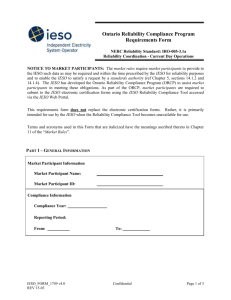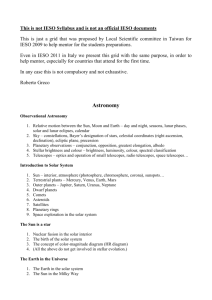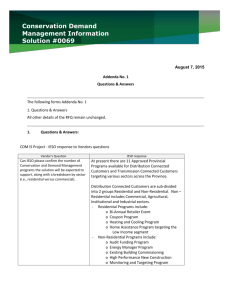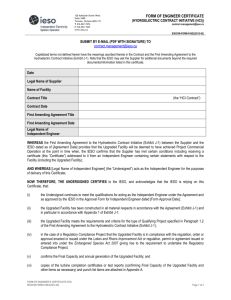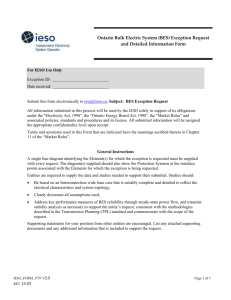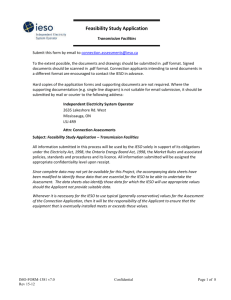Part 2 – Market Rule Amendment Submission Information
advertisement
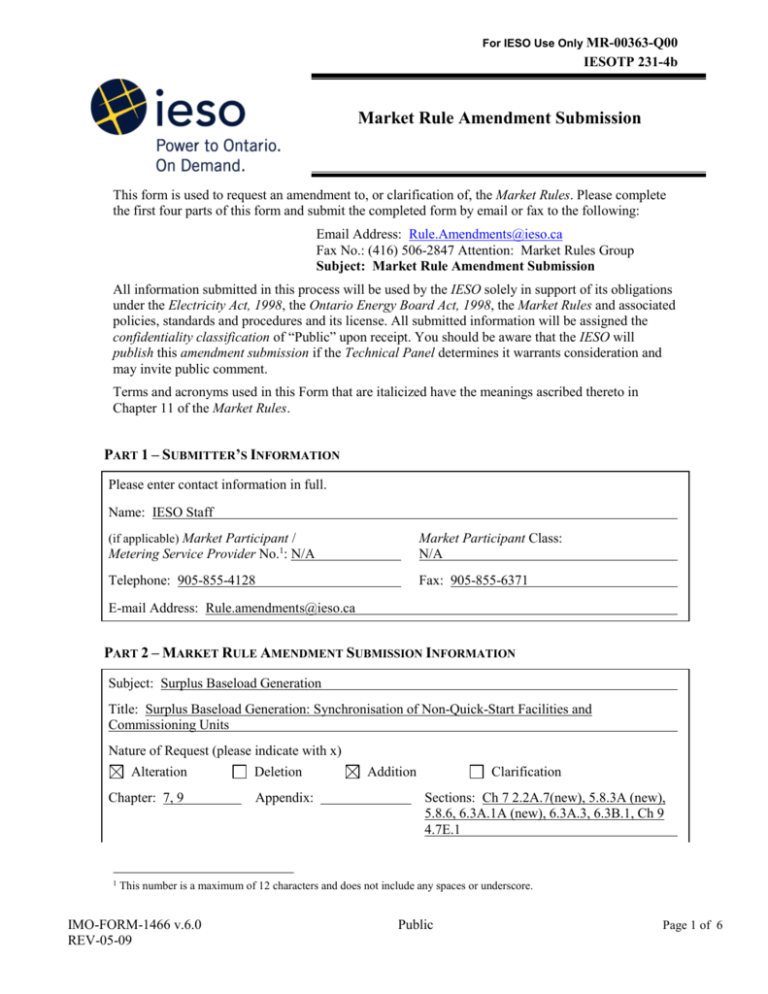
For IESO Use Only MR-00363-Q00 IESOTP 231-4b Market Rule Amendment Submission This form is used to request an amendment to, or clarification of, the Market Rules. Please complete the first four parts of this form and submit the completed form by email or fax to the following: Email Address: Rule.Amendments@ieso.ca Fax No.: (416) 506-2847 Attention: Market Rules Group Subject: Market Rule Amendment Submission All information submitted in this process will be used by the IESO solely in support of its obligations under the Electricity Act, 1998, the Ontario Energy Board Act, 1998, the Market Rules and associated policies, standards and procedures and its license. All submitted information will be assigned the confidentiality classification of “Public” upon receipt. You should be aware that the IESO will publish this amendment submission if the Technical Panel determines it warrants consideration and may invite public comment. Terms and acronyms used in this Form that are italicized have the meanings ascribed thereto in Chapter 11 of the Market Rules. PART 1 – SUBMITTER’S INFORMATION Please enter contact information in full. Name: IESO Staff (if applicable) Market Participant / Metering Service Provider No.1: N/A Market Participant Class: N/A Telephone: 905-855-4128 Fax: 905-855-6371 E-mail Address: Rule.amendments@ieso.ca PART 2 – MARKET RULE AMENDMENT SUBMISSION INFORMATION Subject: Surplus Baseload Generation Title: Surplus Baseload Generation: Synchronisation of Non-Quick-Start Facilities and Commissioning Units Nature of Request (please indicate with x) Alteration Chapter: 7, 9 1 Deletion Appendix: Addition Clarification Sections: Ch 7 2.2A.7(new), 5.8.3A (new), 5.8.6, 6.3A.1A (new), 6.3A.3, 6.3B.1, Ch 9 4.7E.1 This number is a maximum of 12 characters and does not include any spaces or underscore. IMO-FORM-1466 v.6.0 REV-05-09 Public Page 1 of 6 For IESO Use Only MR-00363-Q00 IESOTP 231-4b PART 1 – SUBMITTER’S INFORMATION Sub-sections proposed for amending/clarifying: PART 3 – DESCRIPTION OF THE ISSUE Provide a brief description of the issue and reason for the proposed amendment. If possible, provide a qualitative and quantitative assessment of the impacts of the issue on you and the IESO-administered markets. Include the Chapter and Section number of the relevant market rules. Background Surplus baseload generation (SBG) is a condition that occurs when Ontario’s electricity production from baseload facilities such as nuclear units, other energy sources that cannot be stored (must run hydroelectric units), and other non-dispatchable generation (i.e. wind, solar) is greater than demand. SBG typically occurs during periods when demand is low. With increasing amounts of embedded and renewable resources and greater conservation efforts, it’s expected that SBG will be an enduring and growing problem and the IESO will have to maneuver less flexible generation in order to manage minimum load conditions. In the past and on several occasions of late, the IESO has dispatched nuclear units to manage minimum load conditions, raising concerns about market and system operation impacts associated with possible equipment damage and potentially lengthy delays in returning to service following a shutdown. The IESO is reviewing the management of minimum load conditions as part of stakeholder engagement initiative SE-57 Embedded and Renewable Generation. During that consultation, two issues that exacerbate SBG were identified: (1) The Synchronisation of Non-Quick-Start Facilities Non-quick-start, dispatchable generators may be eligible for real-time and day-ahead generation cost guarantees. If these generators meet the eligibility requirements and accept the guarantee, the IESO applies a constraint such that the facility is scheduled to its minimum loading point for its minimum generation block run times (MGBRT). These generation facilities may have MGBRTs that extend into off-peak hours where SBG typically occurs. If there are other resources available to meet demand, scheduling non-quick-start units during SBG may be an inefficient use of resources if other generation such as nuclear and hydro is being maneuvered or spilled. (2) Commissioning Units The existing market rules have commissioning generation units (i.e. newly constructed or significantly redesigned generation) classified as self-scheduling generators. This permits a commissioning unit to generate independent of supply/demand conditions, as long as the commissioning plan is approved by the IESO. For the same reasons noted above, there may be negative market and operational impacts associated with a commissioning unit generating during SBG. Page 2 of 6 Public IMO-FORM-1466 v.6.0 REV-05-09 For IESO Use Only MR-00363-Q00 IESOTP 231-4b PART 4 – PROPOSAL (BY SUBMITTER) Provide your proposed amendment. If possible, provide suggested wording of proposed amendment. (1) The Synchronization of Non-Quick Start Facilities It is proposed to amend the market rules to allow the IESO to deny non-quick start generators from synchronising to the grid, and to not schedule a generator in the DACP (or EDAC) if SBG is forecasted in at least one hour of the generator’s scheduled minimum generation block run-time. Every weekday, the IESO publishes an hourly forecast of SBG for the next thirty days. The Forecasted SBG Report can be found on the IESO’s website at: http://www.ieso.ca/imoweb/marketdata/sbg.asp. The IESO will be further developing and documenting its SBG forecasting procedures in a market manual and stakeholders will have an opportunity to provide comments on those procedures through SE-57. Real-Time Generation Cost Guarantee (SGOL) a) It is proposed to grant the IESO the explicit authority to deny an SGOL start at the time of the request for synchronization if the IESO forecasts SBG in at least one hour of the generator’s scheduled MGBRT, within 3 hours ahead of the dispatch hour – refer to Ch 7, section 6.3A.1A (new). 6.3A.1A The IESO may deny a generation facility that is not a quick-start facility from synchronising to the IESO-controlled grid if the IESO forecasts surplus baseload generation in accordance with the applicable market manual, in at least one hour of the generation facility’s minimum generation block run-time scheduled in any pre-dispatch schedule determined within 3 hours ahead of the dispatch hour. b) If, for reliability reasons, the IESO directs a generation facility with a real-time guarantee to desynchronize before the end of its MGBRT, that facility remains eligible for the guarantee. For consistency, is it proposed that a facility that synchronized with a guarantee would also remain eligible for the guarantee if the IESO directed the facility to desynchronize before the end of its MGBRT as a result of forecasted SBG in any hour of its MGBRT – refer to Ch 7, section 6.3A.3. 6.3A.3 If the IESO, for reasons of reliability or during periods of forecasted baseload generation under the conditions specified in section 6.3A.1A, constrains off the generation facility such that the generation facility has to de-synchronise before the end of its minimum runtime, the generation facility shall remain eligible for the generation cost guarantee. Day-Ahead Generation Cost Guarantee (DA-GCG) a) It is proposed to grant the IESO the authority to not schedule a generator in the DACP (or EDAC) if the IESO forecasts SBG in at least one hour of the generator’s scheduled MGBRT during the time period from 11:00 EST to the release of the constrained schedules from the predispatch of record - refer to Ch 7, section 5.8.3A (new). 5.8.3A IMO-FORM-1466 v.6.0 REV-05-09 The IESO may, if it forecasts surplus baseload generation in accordance with Public Page 3 of 6 For IESO Use Only MR-00363-Q00 IESOTP 231-4b PART 4 – PROPOSAL (BY SUBMITTER) the applicable market manual, in at least one hour of the generation facility’s minimum generation block run-time scheduled in the constrained schedule of the pre-dispatch of record, during the time period from 11:00 EST to the release of the constrained schedules from the pre-dispatch of record, apply a constraint preventing the commitment of the generation facility in the pre-dispatch of record. b) If the IESO did not forecast SBG in at least one hour of the generator’s scheduled MGBRT until after the generator accepted the DAGCG, it is proposed that the IESO could de-commit the generator as per the existing de-commitment process. The generator would remain eligible for the DA-GCG and may also apply to the IESO for additional fuel cost compensation – refer to Ch 7, sections 5.8.6, 6.3B.1, and Ch 9, section 4.7E.1. Ch 7 5.8.6 The IESO may, to maintain the reliable operation of the IESO-controlled grid, or if the IESO forecasts surplus baseload generation in accordance with the applicable market manual in at least one hour of the generation facility’s minimum generation block runtime, require a generation facility that was included in the constrained schedule from the pre-dispatch of record to either desynchronize from the IESO-controlled grid or to not synchronize to the IESO-controlled grid. ……….. 6.3B.1 If the IESO, for reasons of reliability or during periods of forecasted baseload generation under the conditions specified in section 5.8.6, requires a generation facility that was eligible for the day-ahead generation cost guarantee under section 2.2C and that has accepted the day-ahead generation cost guarantee to either desynchronize from the IESOcontrolled grid or to not synchronize to the IESO-controlled grid such that the generation facility does not meet its minimum run-time requirements, the generation facility shall remain eligible for the day-ahead generation cost guarantee. The registered market participant for the generation facility may also apply to the IESO for additional compensation under section 4.7E.1 of Chapter 9.………. Ch 9 4.7E.1 In the event that the IESO, in order to maintain reliable operation of the IESO-controlled grid, or during periods of forecasted surplus baseload generation, requires a generation facility: that was included in the constrained schedule from the pre-dispatch of record; and for which the registered market participant for the generation facility accepted the day-ahead generation cost guarantee; to either desynchronize from the IESO-controlled grid prior to the end of its minimum runtime or to not synchronize to the IESO-controlled grid, the market participant may, in accordance with chapter 7 section 6.3B, claim, in the manner specified in the applicable market manual, reimbursement of financial losses related to the procurement of fuel for Page 4 of 6 Public IMO-FORM-1466 v.6.0 REV-05-09 For IESO Use Only MR-00363-Q00 IESOTP 231-4b PART 4 – PROPOSAL (BY SUBMITTER) operation at its minimum loading point for its minimum run-time and which was not ultimately utilized by that generation facility. 2) Commissioning Units It is proposed to amend Chapter 7, section 2.2A.7 (new) to allow the IESO to reject, revoke, or recall commissioning test plans/testing schedules for generation facilities in testing mode during periods of forecasted SBG in any hour identified in the commissioning test plan. The current market rules link the scheduling of commissioning test plans to the outage coordination process described in section 6 of Chapter 5. Therefore, it is proposed that the compensation rules that apply to outages that are revoked or recalled (Ch 5, sec 6.7) would also apply to commissioning tests that may be revoked or recalled if SBG is expected during the testing period. Note that market participants may be entitled to compensation for outages that are rejected by the IESO in exceptional circumstances. The proposed amendment is intended to facilitate planning and communications between the IESO and the generator throughout the commissioning phase in determining an agreeable test schedule for the injection of energy into the grid, and to avoid off-peak hours during SBG conditions, whenever possible. Chapter 7 Section 2.2A – Commissioning Units 2.2A.7 The IESO may reject, revoke, or recall the commissioning test plans referred to in section 2.2A.4.2 if the IESO forecasts surplus baseload generation, in accordance with the applicable market manual, in any hour identified in the commissioning test plan. A commissioning generation facility whose commissioning test plan is revoked or recalled by the IESO shall be entitled to compensation for any costs, losses or damage associated with such revocation or recall in accordance with section 6.7 of Chapter 5. PART 5 – FOR IESO USE ONLY Technical Panel Decision on Rule Amendment Submission: MR Number: Date Submitted to Technical Panel: Accepted by Technical Panel as: (please indicate with x) General Urgent Date: Minor Criteria for Acceptance: Priority: IMO-FORM-1466 v.6.0 REV-05-09 Public Page 5 of 6 For IESO Use Only MR-00363-Q00 IESOTP 231-4b PART 5 – FOR IESO USE ONLY Criteria for Assigning Priority: Not Accepted (please indicate with x): Clarification/Interpretation Required (please indicate with x): Technical Panel Minutes Reference: Technical Panel Comments: Page 6 of 6 Public IMO-FORM-1466 v.6.0 REV-05-09
